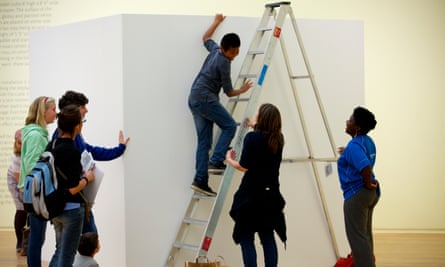Ilya Kabakov, a Ukrainian-born conceptual artist considered to be one of the most influential of the Soviet Union, has died at the age of 89.
Kabakov created dozens of whimsical albums with imaginary, often impossible stories set in the drab but re-stylised surroundings of his Soviet past. He later transformed them into installations, including one about a man who slingshots himself through the roof of his communal flat in order to reach the moon.
The installations lifted Kabakov to international prominence. Emilia, his collaborator and wife, described his worlds to the Guardian in 2018 as the “little heavens we make in our larger hells”.
“It is with great sadness that we announce the passing of Ilya Kabakov, great artist, philosopher, beloved husband, treasured father, and adored grandfather,” said a statement posted on the family’s website this week. “The man who spent his life imagining utopia, departed this world on Saturday.”
His copious illustrations, albums and other works were ubiquitous. Last year, Kabakov’s 1984 schoolbook drawing of ships imposed over the words “go fuck yourself”, was adopted by Russia’s opponents after a famous standoff between Ukrainian soldiers on Snake Island and a Russian warship.
Kabakov, who was born in Dnepropetrovsk (now Dnipro), in Ukraine, in 1933, was one of a team of pioneering artists to work in Moscow during the 1970s and 80s, living as a book illustrator while secretly meeting with a circle of conceptual artists to discuss and exhibit their own independent works.
Kabakov focused on the places – the Soviet homes, businesses and other settings – that he could use as the backdrop for stories about people often striving for a different type of life.

In the late 80s, he emigrated to Long Island, in the US, and remained a prolific artist with Emilia into his 80s.
The two also engaged in social programmes, such as the Ship of Tolerance, a 6-metre (20ft) wooden boat with sails made of paintings by schoolchildren about the merits of understanding across cultures, races and religions. The couple were deeply critical of the election of Donald Trump in 2016, with Emilia telling the Guardian then that she had “come to a different country”.
after newsletter promotion
They lamented the return to a Soviet past, whose enduring presence the couple depicted with a Red Pavilion installation at the 1993 Venice Biennale.
“It turned out that everything that Russia managed to build and change in the past 30 years disappeared overnight, and everything is returning to the same old system of repression,” she told the Art Newspaper last year. “I’m not even mentioning the military operation [in Ukraine], which is in fact the most frightening of wars because it seems possible that it could lead to all-out nuclear war. Everyone is on edge. The entire world has turned upside down. Why this happened, and to what end, no one knows.
“The Red Pavilion has returned. We were told at the time that it would never return, that it is nonsense and we are stuck in the past. But it turns out we weren’t stuck in the past. We were looking into the future. We didn’t want this, but this is as fate would have it.”

